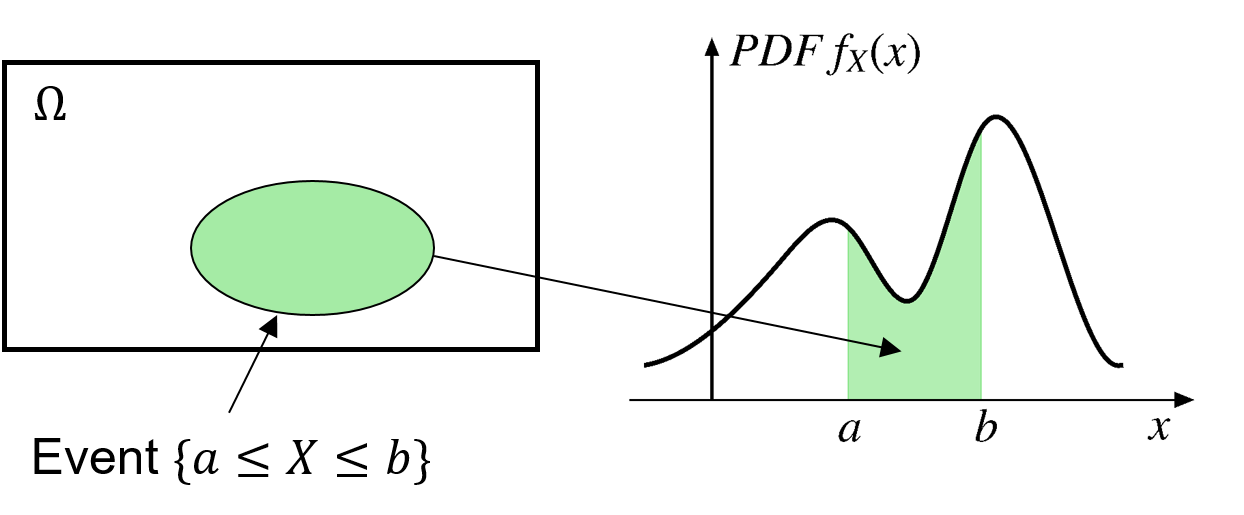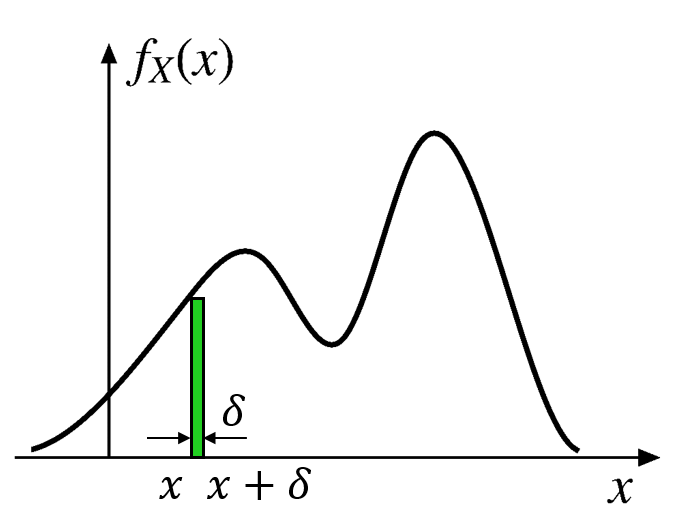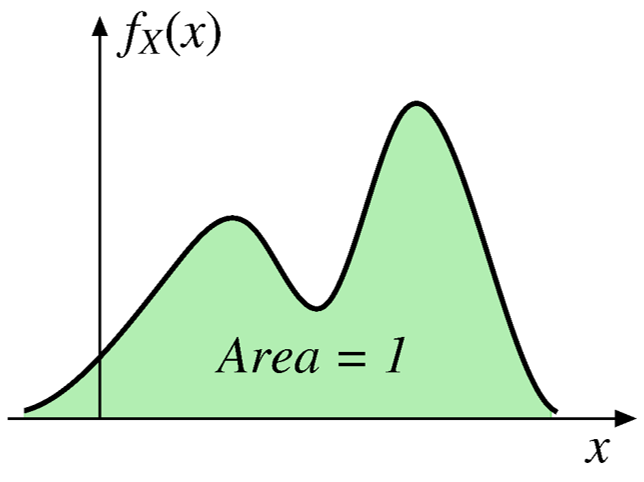4.1 Probability density function
Continuous variables
- It can take on infinitely many, uncountable values.
- If it can take on two particular values, it can also take on all the values between them.
- Examples
- Speed of riding a bicycle
- Water level of a dam
- Customer arrival time at a store
Continuous random variables
A RV \(X\) is called continuous if there is a nonnegative function \(f_X\), such that for every subset \(B\) of the real line

we have
\[ \text{P}(X \in B)=\int_B f_X dx \]
In particular, for one interval \([a, b]\)
\[ \text{P}(a \leq X \leq b)=\int_a^b f_X dx \]
The probability is the definite integral of \(f_X(x)\) from \(a\) to \(b\).
Probability density function
\[ \text{P}(a \leq X \leq b)=\int_a^b f_X dx \]
\(f_X\) is called the probability density function (PDF) of \(X\).

For a discrete RV, \(p_X\) is called the probability mass function.
Why \(f_X\) is called the probability density function?

\[ \small{\text{P}([x, x+\delta])=\int_x^{x+\delta} f_X(t)dt \approx f_X(x) \cdot \delta} \]
\[ \small{f_X(x) \approx \frac{\text{P}([x, x+\delta])}{\delta}} \]
\(f_X\) is the probability mass per unit length.
Properties of PDF
\[ \text{P}(a \leq X \leq b)=\int_a^b f_X dx \]
Non-negativity:
As probability can not be negative, we have
\[ f_X(x) \geq 0, \;\; \text{for all $x$.} \]
Properties of PDF
\[ \text{P}(a \leq X \leq b)=\int_a^b f_X dx \]
Set \(b=a\), we have
\[ \begin{aligned} \text{P}(a \leq X \leq a)&=\int_a^a f_X dx=0 \\ \\ \text{P}(X = a)&=0 \end{aligned} \]
The prob. that a continuous RV takes any single value is 0.
Properties of PDF
\[ \text{P}(X = a)=0 \]
Implication: Including or excluding the endpoints of an interval has no effect on its probability.
\[ \begin{aligned} \text{P}(a \leq X \leq b)&=\text{P}(a < X \leq b) \\ \\ &=\text{P}(a \leq X < b) \\ \\ &=\text{P}(a < X < b) \\ \end{aligned} \]
Properties of PDF
Normalization: For any discrete RV, we have \(\sum_{x} p_X(x) = 1\)
For any continuous RV, we have \[ \text{P}(-\infty < X < +\infty)=\int_{-\infty}^{+\infty} f_X dx=1 \]

Calculus review
Common derivatives
\[ \begin{aligned} \frac{d}{dx}(c)&=0 \\ \\ \frac{d}{dx}(kx)&=k \\ \\ \frac{d}{dx}(x^n)&=nx^{n-1} \\ \end{aligned} \]
\[ \begin{aligned} \frac{d}{dx}(\ln x)&=\frac{1}{x} \\ \\ \frac{d}{dx}(e^x)&=e^x \\ \\ \frac{d}{dx}(a^x)&=a^x \ln(a) \\ \end{aligned} \]
Common integrals
\[ \small{ \begin{aligned} &\int k\;dx=kx+c \\ \\ &\int x^n dx=\frac{x^{n+1}}{n+1}+c, \;\;n \neq -1 \\ \\ &\int \frac{1}{x}dx=\ln |x|+c \\ \end{aligned} } \]
\[ \small{ \begin{aligned} &\int e^x dx=e^x+c \\ \\ &\int a^x dx=\frac{a^x}{\ln a}+c \\ \end{aligned} } \]
\[ \frac{d}{dx}\bigg(f\big(g(x)\big)\bigg)=f'\big(g(x)\big)\cdot g'(x) \]
Fundamental theorem of calculus
\[ \int_a^b f(x)dx=F(x)\bigg|_a ^b=F(b)-F(a) \]
\[ \text{where $F(x)$ is any antiderivative of $f(x)$.} \]